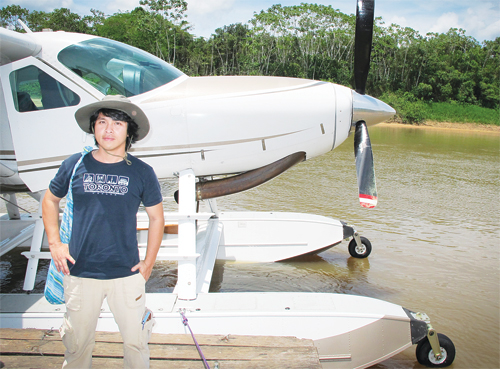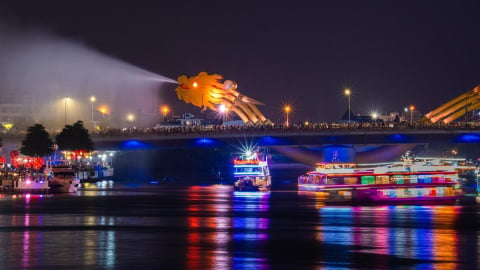A glimmer of hope

The author at Angamos before taking a boat to the Matsés territory - Photo: NT
Before going, I had researched and read a lot of documents about this area. The interesting tribes that I could meet were the Shuar, the Jivaro (famous for shrinking their heads until they were the size of oranges), the Matis (known as the jaguar people) and the Matsés (who were once warriors who stole the wives of other tribes). I spent all day asking dozens of travel agencies and the cultural department in Iquitos (Peru) but all of them shook their heads. "If you want to meet those tribes, in Iquitos, only Amazon Explorer can lead the way," said a member of the Amazon Indigenous Cultural Research Association.
Amazon Explorer is a tour company in Iquitos with only two members: Hector (an Argentine naturalist) and Bertien (a Dutchman, Spanish and English translator). I was quite surprised to hear that I offered to take them to meet “real” Amazon natives. “2,400 USD for a 15-day trip,” Hector said. This was no time to bargain, so I agreed. Hector held out a piece of paper to me: “Sign here.” The paper was full of rules and instructions, but it only summed up in one sentence: “We are not responsible for any accidents that may occur.” “Is there a place to buy insurance?” I asked. Hector laughed: “No company will sell insurance to customers going into the Amazon jungle. And I also warn you, don’t even think about rescue helicopters or anything like that like in the movies. Once you enter the jungle, you accept all risks!”
Matsés Territory
Angamos is considered the last “civilized” place because it still uses battery electricity and has a few small grocery stores. Denis (29 years old) - a Matsés guide who also translates from Matsés to Spanish - picked us up at Angamos.
Today, the Amazon indigenous people are more protected by the government. To enter their territory, you need a permit from the government. A European explorer was once imprisoned in Brazil for lying that he was a friend of the indigenous people and intruding deep into their territory. Even with a permit or bypassing the government, stories of the indigenous people "welcoming" strangers who dare to enter their land with... traps and poisoned arrows have also happened.
The Matsés region is a national reserve, so don’t even think about going on an “exploration” trip on your own. “When you enter a restricted area, anything can happen. If you’re not with the Matsés, opium growers and smugglers will kill strangers because they don’t know if they’re tourists or government agents,” Denis said.
The small boat was loaded with necessities: eggs, condensed milk, soap, dry food… (to give as gifts to the Matsés) and four people: me, Hector, Bertien and Denis set off down the Yavarí River. Pointing to the fork where the Yavarí and Gálvez rivers meet, Denis said: “We are entering Matsés territory”.
Unlike other rivers, the Gálvez River is black because of chemicals secreted by the bark of the trees. These chemicals help filter the water, killing bacteria and mosquito larvae. As a result, there are few mosquitoes in the Matsés area.
Tall cottonwood trees line the Gálvez River, their canopy of leaves spreading all over. Covering the tops of the trees on both sides of the river is the symbol of Honduras (Central America): a flock of colorful, long-tailed Amazon parrots, as big as chickens, arguing loudly. “These parrots are very faithful, always flying in pairs, never flying alone,” Hector revealed.
Occasionally, I saw pink dolphins (a type of freshwater dolphin unique to the Amazon) jumping around in the water. In the documents I read before going, the Matsés people were very afraid of pink dolphins because, according to them, they often disguised themselves as beautiful girls or boys to lure them and then drag them to the bottom of the river. Therefore, the Matsés people did not eat pink dolphins because they believed that their souls would kill them. Just as I was checking that information with Denis, a boat rowed from the opposite side towards Angamos carrying a little boy whose whole body was swollen and almost delirious. “When he was bathing in the river, the pink dolphin swam close to him. So when he got to the shore, he was like this,” the boy’s father (also a Matsés) told Denis in a frightened voice.
The sun was scorching. It was dry season so the water was shallow, and people were still sweaty because of the high humidity. After eight hours sitting on the boat, my body was burned red like a boiled shrimp by the sun. When the sun was about to set behind the old forest, everyone was about to faint from heatstroke and fatigue, and at that moment, we saw small, bare-chested figures… Denis shouted loudly: “We’re here!”
From Iquitos, take a seaplane to Angamos, which takes about a week by boat. From there, continue upstream by motorboat for more than 8 hours to Buen Peru and San Juan (home of the Matsés). Alternatively, take a 19-hour boat ride from Iquitos to Requena (160 km), then walk through the jungle for 3 days and nights. This is a slightly shorter trip, but much more dangerous.


































